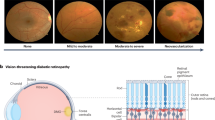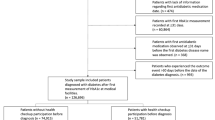Abstract
Aim
A key aim of the photographic screening model for diabetic retinopathy advocated by the National Screening Committee is a reduction in new blindness due to diabetic retinopathy within 5 years. This study determines the incidence of visual impairment due to diabetic retinopathy in Leeds in 2002 and provides a benchmark against which the success of the retinopathy screening programme in Leeds will be judged.
Methods
A retrospective review of all blind and partially sighted registrations for 2002 was conducted. The 2001 Census data and the diabetes prevalence model developed by the Yorkshire and Humber Public Health Observatory were used to determine the total and diabetic populations of Leeds.
Results
Diabetic retinopathy was the primary cause of registration in 24 of the 398 completed records obtained; seven patients were registered blind and 17 partially sighted. For the total population in 2002, the incidence of blind and partially sighted registration due to diabetic retinopathy was 10 per million and 24 per million per year, respectively. For the diabetic population of Leeds in 2002, the incidence of blind and partial sighted registration due to diabetic retinopathy was 337 and 817 per million per year, respectively.
Conclusions
The incidence of blind registration due to diabetic retinopathy in Leeds in 2002 is similar to the estimate provided by the National Screening Committee but higher than the figure from other UK centres.
Similar content being viewed by others
Log in or create a free account to read this content
Gain free access to this article, as well as selected content from this journal and more on nature.com
or
References
Davies R, Rodence P, Brailsford S . The evaluation of screening policies for diabetic retinopathy using simulation. Diabetic Med 2002; 19: 762–770.
Klein R, Klein BEK, Moss SE . Visual impairment in diabetes. Ophthalmology 1984; 91: 1–9.
James M, Turner DA, Broadbent DM, Harding SP . Cost effectiveness analysis of screening for sight threatening diabetic eye disease. BMJ 2000; 320: 1627–1631.
Evans JR . Causes of blindness and partial sight in England and Wales 1990–91, Studies on Medical and Population Subjects Reports No. 57 HMSO: London, 1995.
Evans JR, Rooney C, Ashwood F, Dattani N, Wormald R . Blindness and partial sight in England and Wales: April 1990–March 1991. Health Trends 1996; 28: 5–12.
Wilson JMG, Junner O . The principles and practice of screening for disease. Public Health Papers 34 WEW: Geneva, 1968.
Diabetic Retinopathy Screening Group. Photocoagulation treatment of proliferative diabetic retinopathy. Clinical application of diabetic retinopathy (DRS) findings. DRS Report No. 8. Ophthalmology 1981; 88: 583–600.
Diabetes Control and Complications Trial Research Group. The effect of intensive treatment of diabetes and progression of long term complication in insulin dependent diabetes mellitus. N Engl J Med 1993; 329: 977–986.
Early Treatment Diabetic Retinopathy Study Research Group. Early photocoagulation for diabetic retinopathy. ETDRS Report No. 9. Ophthalmology 1991; 98: 766–785.
Early Treatment Diabetic Retinopathy Study Research Group. Treatment techniques and clinical guidelines for photocoagulation of diabetic macular oedema ETDRS Report No. 2. Ophthalmology 1987; 94: 761–764.
Working Party. Guidelines for Diabetic Retinopathy. Royal College of Ophthalmologists: London, 1997, p 5.
World Health Organisation in Europe and European Region of International Diabetes Federation. The St Vincent Declaration 1989. Diabet Med 1990; 7: 360.
Robinson R, Deutsch J, Jones HS, Youngson-Reilly S, Hamlin DM, Dhurjon L et al. Unrecognised and unregistered visual impairment. Br J Ophthalmol 1994; 78: 736–740.
McCarty DJ, Tull ES, Moy CS, Kwoh CK, LaPorte RE . Ascertainment corrected rates: applications of capture-recapture methods. Int J Epidemiol 1993; 22: 559–565.
Hayward LM, Burden ML, Burden AC, Chang YF . What is the prevalence of visual impairment in the general and diabetic populations: are there ethnic and gender differences? Diabetic Med 2002; 19: 27–34.
Rauf A, Ong PS, Wormald RPL . The pilot study into the prevalence of ophthalmic disease in the Indian population of Southall. J Roy Soc Med 1994; 84: 78–79.
Pardhan S, Mahomed I . The clinical characteristics of Asian and Caucasian patients on Bradford's Low Vision Register. Eye 2002; 16: 572–576.
Prasad S, Kamath G, Jones K, Clearkin LG, Phillips RP . Prevalence of blindness and visual impairment in a population of people with diabetes. Eye 2001; 15: 640–643.
Mather H, Keen H . The Southall Diabetes Survey: prevalence of known diabetes in Asians and Europeans. BMJ 1985; 291: 1081–1084.
McKibbin M, Walters G, O'Neil D . Current diabetic retinopathy screening by general practitioner practices in Leeds, Poster at the Royal College of Ophthalmologists Annual Congress, Cardiff, 1999.
Ghafour IM, Allan D, Foulds WS . Common causes of blindness and visual handicap in the west of Scotland. Br J Ophthalmol 1988; 67: 209–213.
Aclimandos WA, Galloway NR . Blindness in the city of Nottingham (1980–85). Eye 1988; 2: 431–434.
Munier A, Gunning T, Kenny D, O'Keefe M . Causes of blindness in the adult population of the Republic of Ireland. Br J Ophthalmol 1998; 82: 630–633.
Bamashmus MA, Mathiga B, Dutton GN . Causes of blindness and visual impairment in West of Scotland. Eye 2004; 18: 257–261.
Cormack TGM, Grant B, Macdonald MJ, Campbell IW . Incidence of blindness due to diabetic eye disease in Fife 1990–9. Br J Ophthalmol 2001; 85: 354–356.
Thompson JR, Du l, Rosenthal AR . Recent trends in the registration of blindness and partial sight in Leicestershire. Br J Ophthalmol 1989; 73: 95–99.
Arun CS, Ngugi N, Taylor R . Effectiveness of screening in preventing blindness due to diabetic retinopathy. Diabetic Med 2003; 20: 186–190.
World Health Organisation. International classification of impairments, disabilities and handicaps. WHO: Geneva, 1980, pp 79–85.
Form BP1 (2R). Edinburgh: The Scottish Office Home and Health Department, St Andrew's House.
Record of examination to certify a person as blind or partially sighted (BD8 1990). Guidance Notes. The Stationery Office: London.
Rhatigan MC, Leese GP, Ellis J, Ellingford A, Morris AD, Newton RW et al. Blindness in patients with diabetes who have been screened for eye disease. Eye 1999; 13: 166–169.
Acknowledgements
We thank the staff of Leeds Social Services and Mr Keith Jackson for their cooperation and secretarial support in conducting this study. Miss Sharmila Jivan was instrumental in data collection and assimilation.
Author information
Authors and Affiliations
Corresponding author
Additional information
The authors have no proprietary or financial interest in any of the products
Rights and permissions
About this article
Cite this article
Kumar, N., Goyder, E. & McKibbin, M. The incidence of visual impairment due to diabetic retinopathy in Leeds. Eye 20, 455–459 (2006). https://doi.org/10.1038/sj.eye.6701908
Received:
Accepted:
Published:
Issue date:
DOI: https://doi.org/10.1038/sj.eye.6701908



